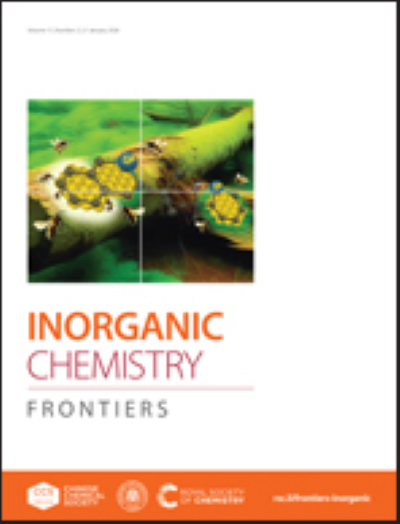Hg2(HTe2O5)(PO4):通过多种官能团的协同修饰增强双折射的新型磷酸盐晶体
IF 6.1
1区 化学
Q1 CHEMISTRY, INORGANIC & NUCLEAR
引用次数: 0
摘要
双折射晶体是光学器件小型化的关键。磷酸盐晶体具有高度对称的四面体结构,具有优异的稳定性和宽的光学带隙。然而,它们固有的对称性通常导致低双折射率,大多数磷酸盐化合物的双折射率值低于0.1。通过引入高各向异性离子和基团来增强双折射的努力受到磷酸盐的四面体配位的阻碍,这往往导致各向异性效应的消除。为了解决这一挑战,我们提出了一种利用多个官能团的协同修饰来破坏磷酸盐晶体中的各向异性抵消并显着增强其双折射的方法。具体来说,我们将具有立体化学活性的孤对Te(IV)和以其高极化性和可变形性而闻名的Hg(II)纳入磷酸盐体系。我们合成了一种新的磷酸盐化合物Hg2(HTe2O5)(PO4),它在546 nm处的计算双折射为0.162,在546 nm处的测量双折射为0.168。该值与商用双折射材料CaCO3 (Δn=0.172@546 nm)相当,超过了大多数先前报道的磷酸盐材料。此外,Hg2(HTe2O5)(PO4)具有较宽的带隙和优异的稳定性。利用PAWED方法,我们确定了Hg2(HTe2O5)(PO4)的显著双折射主要是由于HgO7多面体(19.86%),PO4四面体(29.17%)和Te2O5基团(47.40%)的共同贡献。我们的工作表明,多官能团的协同修饰是增强四面体化合物双折射的有效策略,为高性能双折射材料的开发提供了新的途径。本文章由计算机程序翻译,如有差异,请以英文原文为准。
Hg2(HTe2O5)(PO4): A novel phosphate crystal with enhanced birefringence enabled by the synergistic modification of multiple functional groups
Birefringent crystals are crucial for the miniaturization of optical devices. Phosphate crystals, characterized by their highly symmetrical tetrahedral structures, exhibit excellent stability and wide optical bandgaps. However, their intrinsic symmetry typically results in low birefringence, with most phosphate compounds having birefringence values below 0.1. Efforts to enhance birefringence by introducing highly anisotropic ions and groups have been impeded by the tetrahedral coordination of phosphate, which often leads to the cancellation of anisotropic effects. To address this challenge, we propose an approach that leverages the synergistic modification of multiple functional groups to disrupt the anisotropic cancellation in phosphate crystals and significantly enhance their birefringence. Specifically, we incorporate Te(IV), which features stereo-chemically active lone pairs, and Hg(II), known for its high polarizability and deformability, into the phosphate system. We synthesized a novel phosphate compound, Hg2(HTe2O5)(PO4), which exhibits a calculated birefringence of 0.162 at 546 nm and a measured birefringence of 0.168 at 546 nm. This value is comparable to that of the commercial birefringent material CaCO3 (Δn=0.172@546 nm) and surpasses most previously reported phosphate materials. Additionally, Hg2(HTe2O5)(PO4) demonstrates a wide bandgap and excellent stability. Using the PAWED method, we determined that the significant birefringence of Hg2(HTe2O5)(PO4) is primarily due to the combined contributions of the HgO7 polyhedra (19.86%), PO4 tetrahedra (29.17%), and Te2O5 groups (47.40%). Our work demonstrates that the synergistic modification of multiple functional groups is an effective strategy for enhancing the birefringence of tetrahedral compounds, providing a new pathway for the development of high-performance birefringent materials.
求助全文
通过发布文献求助,成功后即可免费获取论文全文。
去求助
来源期刊

Inorganic Chemistry Frontiers
CHEMISTRY, INORGANIC & NUCLEAR-
CiteScore
10.40
自引率
7.10%
发文量
587
审稿时长
1.2 months
期刊介绍:
The international, high quality journal for interdisciplinary research between inorganic chemistry and related subjects
 求助内容:
求助内容: 应助结果提醒方式:
应助结果提醒方式:


